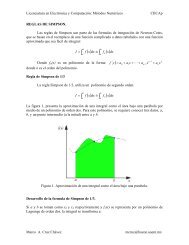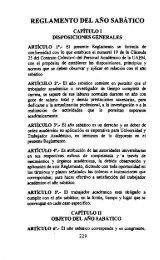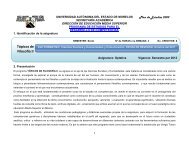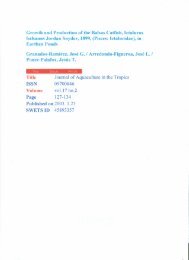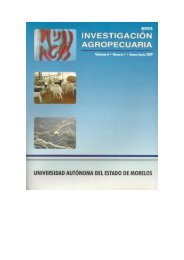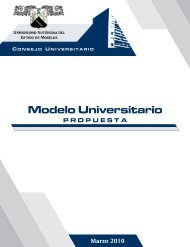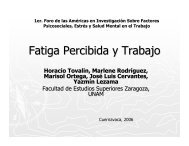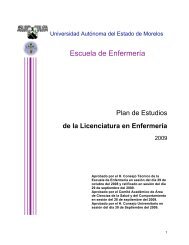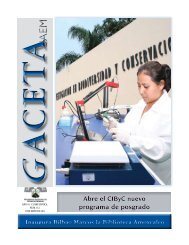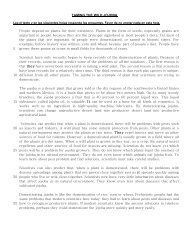Descargar - UAEM - Universidad Autónoma del Estado de Morelos
Descargar - UAEM - Universidad Autónoma del Estado de Morelos
Descargar - UAEM - Universidad Autónoma del Estado de Morelos
Create successful ePaper yourself
Turn your PDF publications into a flip-book with our unique Google optimized e-Paper software.
Investigación Agropecuaria. 2010. Volumen 7(1). p. 7-20<br />
_________________________________________________________________________________________________________<br />
CURVA DE CRECIMIENTO DEL PASTO LLANERO (Andropogon gayanus Kunth)<br />
DURANTE LA ÉPOCA LLUVIOSA EN EL NORTE DEL ESTADO DE YUCATÁN<br />
Alejandro Ayala Sánchez 1* , Jorge A. Basulto Graniel 2<br />
1<br />
Instituto Nacional <strong>de</strong> Investigaciones Forestales, Agrícolas y Pecuarias. Campo Experimental Zacatepec.<br />
Correo-e: ayalasa@hotmail.com<br />
2<br />
Instituto Nacional <strong>de</strong> Investigaciones Forestales, Agrícolas y Pecuarias. Campo Experimental Mocochá.<br />
Correo-e: basulto.jorge@inifap.gob.mx<br />
* Autor para correspon<strong>de</strong>ncia<br />
RESUMEN 1<br />
El pasto llanero se ha mostrado<br />
prometedor para el mejoramiento <strong>de</strong> la<br />
gana<strong>de</strong>ría <strong><strong>de</strong>l</strong> norte <strong>de</strong> Yucatán. En este<br />
trabajo se <strong>de</strong>scribe la curva <strong>de</strong> crecimiento<br />
ininterrumpido <strong><strong>de</strong>l</strong> pasto, mostrando que<br />
bajo un período <strong>de</strong> lluvia normal para la<br />
zona es capaz <strong>de</strong> producir en siete meses y<br />
en forma lineal un total <strong>de</strong> 11.6 ton/ha <strong>de</strong><br />
MS, <strong>de</strong> las cuales, en promedio <strong>de</strong> 12<br />
cortes, el material ver<strong>de</strong> constituyó el 80%<br />
mientras que el restante 20% fue el material<br />
muerto; la hoja ver<strong>de</strong> y el tallo ver<strong>de</strong>,<br />
constituyentes <strong><strong>de</strong>l</strong> material ver<strong>de</strong>,<br />
promediaron 42.7 y 57.3%, respectivamente.<br />
La inflorescencia <strong>de</strong> llanero se presentó en<br />
noviembre y constituyó el 10% <strong><strong>de</strong>l</strong> forraje<br />
total. Se concluye que llanero es un pasto<br />
con alto potencial para la zona norte <strong><strong>de</strong>l</strong><br />
estado <strong>de</strong> Yucatán.<br />
Palabras clave: llanero, Andropogon<br />
gayanus, Yucatán, crecimiento<br />
1 Recibido: 8/05/2010 ; Aceptado: 22/06/2010<br />
7<br />
ABSTRACT<br />
Andropogon gayanus is a promise<br />
material for <strong>de</strong>velopment of the North of<br />
Yucatan animal husbandry. This work<br />
<strong>de</strong>scribes the continue growing curve of<br />
llanero grass, which un<strong>de</strong>r normal rain<br />
station did show in seven months its<br />
capacity to produce a total of 11.6 ton/ha of<br />
DM (dry matter). From this forage produced,<br />
in average from 12 cuts, llanero contains<br />
80% of green material and 20% of <strong>de</strong>ath<br />
material; green leaf and green stem, as part<br />
of green material, constituted in average,<br />
42.7 and 57.3%, respectively. The<br />
inflorescence of llanero was present at<br />
November and constituted a 10% of the total<br />
forage produced. It was conclu<strong>de</strong> that<br />
llanero is a grass with high potential for the<br />
animal husbandry at North of Yucatan.<br />
Key words: Andropogon gayanus, growth,<br />
Yucatan, forage production



